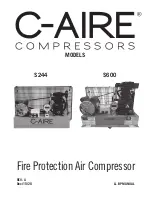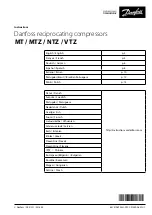
Drain valve
6
3
KOBE
PROFESSIONAL
AIR TOOLS
ELECTRICAL INFORMATION
In the United Kingdom, the
ELECTRICITY AT WORK ACT 1989
requires all portable electrical appliances, if
used on business premises, to be tested by a qualified electrician, using a Portable Appliance Tester (PAT), at
least once a year. The
HEALTH & SAFETY AT WORK ACT 1974
makes owners of electrical appliances
responsible for the safe condition of the appliance and the safety of its operator. If in any doubt about
electrical safety, contact a qualified electrician.
KOBE
PROFESSIONAL
AIR TOOLS
SPECIFICATIONS
WORKING PRESSURE (max.)
..........
8Bar/115PSI
PUMP AIR DISPLACEMENT (min.)
.............................
.............................................................................................
8FM/230Ltr
AIR RECEIVER TANK CAPACITY
......................
23Ltr
MOTOR CAPACITY
....................................................
1.49KW
MOTOR ROTATION SPEED
.............................
2850rpm
MOTOR SUPPLY VOLTAGE
.......................
230V/50Hz
MOTOR HP
..................................................................................
2HP
ACOUSTIC PRESSURE LWA (max.)
............
84dBa
NET DIMENSIONS
..................
60(H) x 36(W) x 57(D)cm
NET WEIGHT
................................................................................
30kg
QUICK CONNECT COUPLER
.............1/
4
” BSP Female
The room temperature for its correct efficiency is 0
°
C
to +25
°
C (Max 45
°
C).
KOBE
PROFESSIONAL
AIR TOOLS
ASSEMBLY
Fig.1
Fig. 2
TOOLS NEEDED:
Snipe nose plier.
Remove the temporary air filter cap (See fig. 1) and
install the air filter assembly (See fig. 2).
Never use the
air compressor without having the air filter installed.
KOBE
PROFESSIONAL
AIR TOOLS
COMPONENTS
Non
return-valve
on/off
lever
Safety
blow off
valve
Pre-set
pressure
switch
Thermal
overload
protection
cutout
Motor and
pump unit
Air receiver tank
Tank
pressure
gauge
Line
pressure
gauge
Air outlet
pressure
regulator
Quick connect
coupler
Air filter
assembly
KOBE
PROFESSIONAL
AIR TOOLS
TROUBLESHOOTING
POSSIBLE CAUSE
Air leaks at connections.
The non-return valve seal
is defective.
The overload cut-out has
operated because of the
motor overheating or the
voltage supply to the
motor is low.
The motor windings have
burnt out.
The capacitor has burnt
out.
The air compressors head
gasket has broken or the
valve is faulty.
The air compressors head
gasket has broken or the
valve is faulty.
The pressure switch needs
adjusting.
The tank is full of water
due to condensation.
SOLUTION
Let the compressor build pressure in the tank;
to the maximum pressure if possible. Switch
off. Brush soapy water on air connections and
look carefully for air bubbles. Tighten leaking
connections. If the fault persists, contact your
local Kobe agent.
Let the air in the tank flow out until all the
pressure is released. Then remove the non
return-valve plug and clean the valve seat. If
necessary replace the ‘O’ ring seal and then re-
mount all the components (See fig. 10).
Check that the mains voltage corresponds to
the specifications. An extension cable, which is
too thin and too long, can cause the motor to
overheat. Leave the air compressor to cool
down as the thermal cut out has operated. Use
heavy duty extension cables. Ensure that the
compressor is plugged into a socket as near to
the consumer unit/fuse box as possible.
Contact your local Kobe agent.
Replace the starter capacitor.
Stop the air compressor and contact your local
Kobe agent.
Stop the air compressor and contact your local
Kobe agent.
Stop the air compressor and contact your local
Kobe agent.
Connect an air hose with a low gun fitted and
release the pressure. Open the drain valve
underneath the air compressor and release the
water within the tank.
FAULT
Pressure drops.
The pressure switch valve
leaks when the
compressor is idle.
The compressor has
stopped, does not start or
starts slowly
The compressor has
stopped, does not start.
The motor does not start
and makes a humming
noise.
The air compressor is
noisy with metallic clangs.
The air compressor does
not reach the maximum
pressure.
The air compressor
doesn’t seem to provide
as much air as it did when
new and the air
compressor cuts off within
a much shorter time
period.
Repairs must be performed in a dirt-free environment by a qualified person who is familiar
with this type of equipment. Make sure the air receiver tank is de-pressurised before
carrying out any repairs.






















